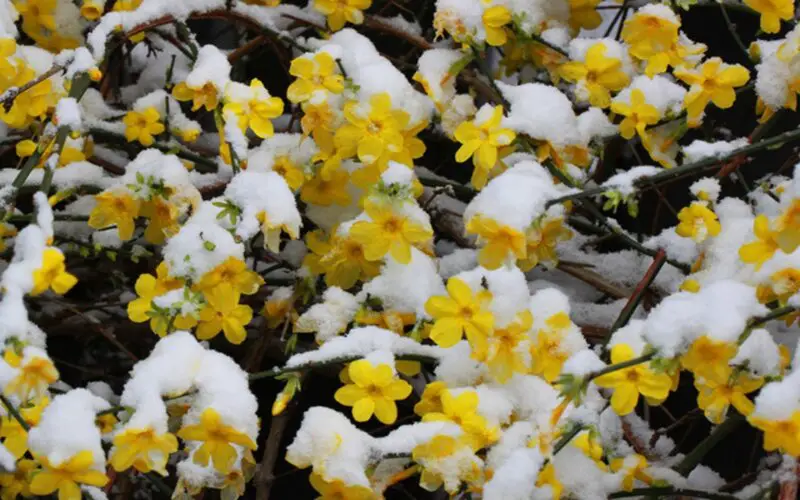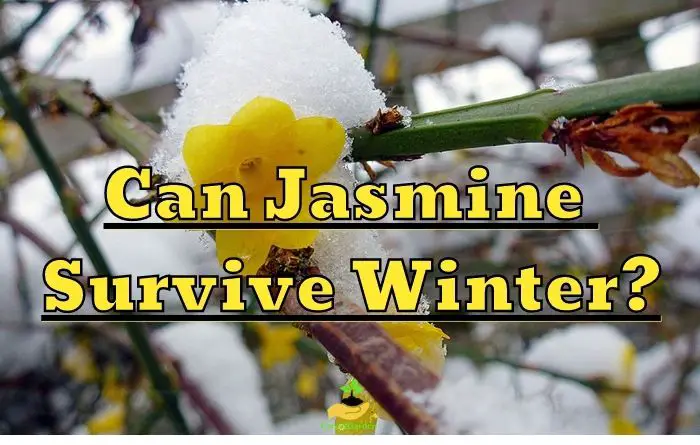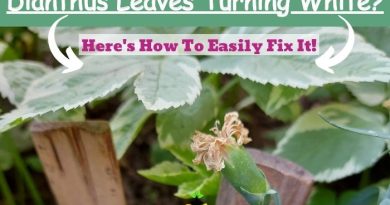Can Jasmine Survive Winter? Answer May Surprise You!
Jasmine, with its delicate and fragrant blooms, is a beloved flowering plant among gardeners. However, when winter arrives, many wonder if jasmine can survive winter and withstand the harsh conditions.
In this article, we will delve into the factors that affect jasmine’s winter survival and provide comprehensive guidance on how to help your jasmine plant thrive during the colder months.
Can Jasmine survive winter?
Yes, jasmine can survive winter, but its ability to withstand cold temperatures varies depending on the variety and hardiness zone. Winter Jasmine and Italian Jasmine are more resilient, thriving in USDA Hardiness Zones 6-10 and 7-10 respectively. However, proper care is crucial for all jasmine plants during winter. Protect them with mulch, shield from harsh winds, provide adequate hydration, and consider pruning and covering fragile varieties. By following these guidelines, you can increase the chances of your jasmine surviving and thriving through the winter months.
Table with jasmine varieties known for their cold hardiness
| Jasmine Variety | Winter Hardiness Zone | Lowest Temperature Supported |
|---|---|---|
| Winter Jasmine (Jasminum nudiflorum) | USDA Zones 6-10 | -10°F (-23°C) |
| Italian Jasmine (Jasminum humile) | USDA Zones 7-10 | 10°F (-12°C) |
| Pink Jasmine (Jasminum polyanthum) | USDA Zones 8-11 | 10°F (-12°C) |
| Common Jasmine (Jasminum officinale) | USDA Zones 7-10 | 10 to 15°F / -12 to -9°C |
| Carolina Jasmine (Gelsemium sempervirens) | USDA Zones 7-9 | 15°F (-9°C) |
| Arabian Jasmine (Jasminum sambac) | USDA Zones 9-11 | 20 to 25°F / -6 to -4°C |
| Star Jasmine (Trachelospermum jasminoides) | USDA Zones 8-11 | 10°F (-12°C) |
| Confederate Jasmine (Trachelospermum jasminoides) | USDA Zones 8-10 | 10 to 15°F / -12 to -9°C |
| Chilean Jasmine (Mandevilla laxa) | USDA Zones 8-10 | 15 to 20°F / -9 to -6°C |
https://hgic.clemson.edu/factsheet/jasmine/
Jasmine, with its delicate and fragrant blossoms, brings joy to gardens and indoor spaces alike. However, when winter arrives, it raises the question of whether jasmine can withstand the challenges of the cold season. While jasmine plants may not be as hardy as some other species, their survival during winter is possible with the right care.
Factors such as temperature, hardiness, and overall plant health significantly impact Jasmine’s ability to endure the winter months.
By understanding these factors and implementing appropriate measures, you can increase the chances of your jasmine plant thriving even in the face of freezing temperatures and frosty conditions.
Factors Affecting Jasmine Winter Survival
Several key factors play a crucial role in determining the ability of jasmine plants to survive the harsh conditions of winter. These factors directly impact the plant’s overall health and resilience, influencing its ability to withstand cold temperatures.
Understanding how each factor affects Jasmine is essential for providing the necessary care and protection to ensure its successful winter survival. Let’s explore these factors in detail to help you better prepare and support your jasmine plants during the colder months.
Temperature
The exposure to cold temperatures presents a significant challenge for jasmine plants, as most varieties are not frost-tolerant. When exposed to freezing temperatures for extended periods, jasmine can suffer damage or even die.
It is crucial, therefore, to consider the minimum winter temperatures in your region and choose jasmine varieties that are suitable for those conditions.
By selecting jasmine varieties that are more tolerant of cold temperatures, you increase the chances of their survival during winter.
Hardiness
Different jasmine species and cultivars exhibit varying levels of hardiness, as you’ve seen in the table above. According to my research, some varieties, such as winter jasmine (Jasminum nudiflorum), are known to be more cold-tolerant and can withstand freezing temperatures better than others.
When selecting jasmine for your garden, it is important to research the specific hardiness zone recommendations for the particular variety you are interested in.
By choosing jasmine varieties that are recommended for your hardiness zone, you provide them with the best chance of surviving winter successfully.
Plant Health
The overall health and vigor of the jasmine plant also play a crucial role in its ability to survive the winter. A plant that is already stressed or weakened due to diseases, pests, or poor growing conditions is more susceptible to winter damage. Therefore, it is essential to ensure that your jasmine plant is healthy and well-maintained throughout the growing season.
Regularly inspect the plant for any signs of diseases or pests and take appropriate measures to control them. Providing proper nutrition, watering, and ensuring adequate sunlight will contribute to the plant’s overall health and resilience. By maintaining a healthy jasmine plant, you increase its ability to withstand the challenges of winter.
Common signs of winter damage on jasmine plants
| Signs of Winter Damage In Jasmine | Description |
|---|---|
| Leaf Browning | Jasmine leaves may turn brown or develop brown patches due to frost or freezing temperatures. |
| Leaf Drop | Some jasmine varieties may experience leaf drop during winter as a natural response to colder temperatures. |
| Stem Browning | Cold temperatures can cause the browning or discoloration of jasmine stems, indicating potential damage. |
| Flower Damage | If jasmine blooms during winter, frost or freezing temperatures can damage or kill the flowers, causing them to wilt or turn brown. |
| Stunted Growth | Jasmine plants may exhibit slower growth or stunted growth during winter as a result of the colder conditions. |
| Dieback | Severe winter damage can cause sections of jasmine plants to die back, resulting in the loss of stems or branches. |
| Cracked Bark | Extremely low temperatures can cause the bark of jasmine plants to crack or split, potentially leading to further damage. |
| Lack of New Growth | Insufficient or delayed new growth in spring may indicate winter damage on jasmine plants. |
Discover here the reasons why jasmine leaves, turn from lush green to striking red.
How to Help Jasmine Survive Winter

To assist your jasmine plant in weathering the winter months, here are some important steps and considerations to follow:
Preparing for Winter Dormancy
As winter approaches, it is crucial to prepare your jasmine for dormancy. Start by gradually reducing watering and fertilizer applications in the fall. This signals to the plant that it is time to slow down its growth and prepare for the colder months. Additionally, avoid any pruning during this period, as it may stimulate new growth that is vulnerable to frost damage.
Examining Jasmine’s Hardiness Zones
Determining the appropriate hardiness zone for your area is paramount before planting jasmine in your garden. The United States Department of Agriculture (USDA) assigns hardiness zones based on average minimum winter temperatures. Selecting jasmine varieties recommended for your zone significantly increases their chances of surviving winter successfully.
Protecting from Cold
When winter arrives, providing some form of protection can help shield your jasmine plant from freezing temperatures.
Here are a few methods you can follow:
Mulching: Apply a layer of organic mulch around the base of the jasmine plant. This serves as insulation, helping to regulate soil temperature during winter and protect the roots.
Covering: Utilize a frost cloth or blanket to cover the jasmine plant during particularly cold nights. This additional layer of insulation safeguards the plant from frost damage.
Shelter: If possible, consider relocating potted jasmine plants to a protected area, such as a greenhouse or a covered porch, during the coldest periods of winter.
Watering Considerations
While it is essential to reduce watering as winter approaches, it is equally crucial to ensure that the jasmine plant does not suffer from dehydration. Monitor the soil moisture levels and provide water when necessary, keeping in mind that jasmine plants require less water during dormancy.
Water very sparingly but regularly during the hibernation so that the soil ball never dries out completely. When temperatures rise in spring, the jasmine can be warmed up again. Then it is advisable to air it out every now and then and slowly get the plant used to the outdoor conditions on the terrace again.
Pest and Disease Prevention
Preventing pest infestations and diseases is crucial for Jasmine’s winter survival. Inspect the plants regularly for any signs of pests or diseases and take appropriate measures to control them. Remove any dead or decaying plant material that could harbor pests or fungal infections. Maintaining good hygiene in and around the jasmine plants will help prevent the spread of diseases.
Pruning
While pruning should be avoided during the fall and winter months, it is beneficial to prune jasmine plants in late winter or early spring before new growth begins. This helps remove any damaged or dead branches and encourages healthy growth for the upcoming season.
Monitoring Weather Conditions
Stay informed about the weather conditions during winter. If a sudden cold snap or frost is predicted, take immediate action to protect your jasmine plants. Stay prepared with frost cloths, blankets, or other protective coverings that can be quickly deployed when needed.
Patience and Observation
During the winter months, jasmine plants may appear dormant or show signs of stress. It is important to be patient and allow the plant to go through its natural dormancy period.
Avoid the temptation to overwater or provide excessive care, as this can do more harm than good. Instead, observe the plant closely and make adjustments as necessary based on its specific needs.
What is the lowest temperature a jasmine can tolerate?
The lowest temperature a jasmine can generally tolerate depends on the specific variety and its hardiness. However, most common jasmine varieties can withstand temperatures down to approximately 20°F (-6°C) without significant damage.
Hardy varieties like Winter Jasmine (Jasminum nudiflorum) and Italian Jasmine (Jasminum humile) can tolerate even lower temperatures, often surviving down to -10°F (-23°C) or lower.
It’s important to note that extreme or prolonged cold spells can still be detrimental to jasmine plants, so providing additional protection during severe winter conditions is recommended for optimal survival.
Does jasmine grow back after winter?
Yes, jasmine plants typically grow back after winter. While some varieties may lose their leaves during the winter months, they are generally able to regrow and flourish when the weather warms up in spring.
Frost-tolerant jasmine species tolerate light frosts of up to 23°F (-5°C). It is best to overwinter these plants in a protected place in the garden, in a cold greenhouse, in a basement or in the garage. Real jasmine, for example, is considered to be frost-tolerant. Frost-sensitive species do not tolerate frost at all.
However, the extent of regrowth and the time it takes for jasmine plants to recover can vary depending on the specific variety, the severity of winter conditions, and the care provided during the dormant period. Providing proper winter protection, such as mulching and shelter from harsh winds, can help enhance the chances of healthy regrowth in jasmine plants after winter.
Is star jasmine hardy?
The star jasmine is only conditionally hardy. Therefore, if possible, the plant should be overwintered in a bright, frost-free place, such as a conservatory or a shed, at 37 to 64°F (3 to 18 °C). With star jasmine planted out in the garden, the winter sun draws moisture from the leaves, even on cold or frosty days. So that the plant does not dry out, the soil must always be sufficiently moist. If necessary, water during frost-free weather periods when the natural precipitation is not sufficient.




